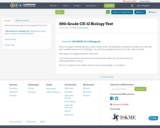
10th grade biology aligned to the standards that is free.
- الموضوع:
- Life Science
- نوع المادة:
- المقرر التعليمي الكامل
- Date Added:
- 05/13/2015

10th grade biology aligned to the standards that is free.
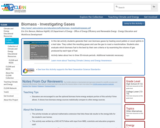
In this lab activity students generate their own biomass gases by heating wood pellets or wood splints in a test tube. They collect the resulting gases and use the gas to roast a marshmallow. Students also evaluate which biomass fuel is the best by their own criteria or by examining the volume of gas produced by each type of fuel.
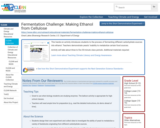
This hands-on activity introduces students to the process of fermenting different carbohydrate sources into ethanol. Teachers demonstrate yeasts' inability to metabolize certain food sources.
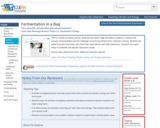
This is a hands-on inquiry activity using zip-lock plastic bags that allows students to observe the process of fermentation and the challenge of producing ethanol from cellulosic sources. Students are asked to predict outcomes and check their observations with their predictions. Teachers can easily adapt to materials and specific classroom issues.
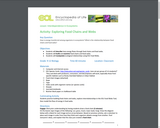
Students practice building food chains and webs, explore interrelationships in the EOL Food Webs Tool, then model the flow of energy in food webs.
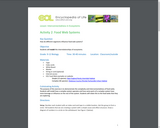
Students model how a complex system operates and how some parts of a complex system have more leverage or influence on the rest of the system. Students relate this to the interconnectedness of food webs.
Take a breath — where does the oxygen you inhaled come from? In our changing world, will we always have enough oxygen? What is in water that supports life? What is known? How do we know what we know about our vast oceans? These are just a few of the driving questions explored in this interactive STEAM high school curriculum module.
Students in marine science, environmental science, physics, chemistry, biology, integrated science, biotechnology and/or STEAM courses can use this curriculum module in order to use real-world, big data to investigate how our “invisible forest” influences ocean and Earth systems. Students build an art project to represent their new understanding and share this with the broader community.
This 4-week set of lessons is based on the oceanographic research of Dr. Anne Thompson of Portland State University in Oregon, which focuses on the abundant ocean phytoplankton Prochlorococcus. These interdisciplinary STEAM lessons were inspired by Dr. Thompson’s lab and fieldwork as well as many beautiful visualizations of Prochlorococcus, the ocean, and Earth. Students learn about the impact and importance of Prochlorococcus as the smallest and most abundant photosynthetic organism on our planet. Through the lessons, students act as both scientists and artists as they explore where breathable oxygen comes from and consider how to communicate the importance of tiny cells to human survival.
This module is written as a phenomenon-based, Next Generation Science Standards (NGSS) three-dimensional learning unit. Each of the lessons below also has an integrated, optional Project-Based Learning component that guides students as they complete the PBL process. Students learn to model a system and also design and evaluate questions to investigate phenomena. Students ultimately learn what is in a drop of ocean water and showcase how their drop contributes to our health and the stability and dynamics of global systems.
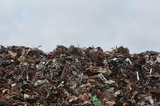
Food waste is a major contributor to greenhouse gas. Wasted food and the resources to produce that food are responsible for approximately 8% of global greenhouse gas emissions. In this storyline, students learn about the resources required to produce food through following the carbon cycle and discover how food waste contributes to climate change. They will also learn the farm to table transport chain as well as how to conduct a food waste assessment. Finally, the students will research solutions to the problem of food waste and, as a final project, present one solution that they have thoroughly researched that can be applicable to their community. For CTE teachers, this storyline provides the basic knowledge needed to develop a deep understanding of WHY reducing food waste is an important solution to climate change. There are several potential extensions that Family Consumer Science teachers can utilize as well as Ag teachers and even Business teachers. There is a partial list at the end of the learning progressions.

El desperdicio de comida es uno de los principales contribuyentes a los gases de efecto invernadero. Los alimentos desperdiciados y los recursos para producirlos son responsables de aproximadamente el 8% de las emisiones mundiales de gases de efecto invernadero. En este caso, los estudiantes aprenden sobre los recursos necesarios para producir alimentos a través del ciclo del carbono y descubren cómo el desperdicio de alimentos contribuye al cambio climático. También aprenderán la cadena de transporte de la granja a la mesa y cómo llevar a cabo una evaluación de desperdicio de comida. Finalmente, los estudiantes investigarán soluciones al problema del desperdicio de comida y, como proyecto final, presentarán una solución que han investigado a fondo que puede ser aplicable a su comunidad. Para los maestros de CTE, este caso proporciona el conocimiento básico necesario para desarrollar una comprensión profunda de POR QUÉ reducir el desperdicio de comida es una solución importante para el cambio climático. Hay varias extensiones potenciales que los maestros de ciencias del consumo familiar pueden utilizar, así como los maestros de Agricultura e incluso los maestros de Negocios. Hay una lista parcial al final de las progresiones de aprendizaje.

Our Patterns Biology development team of teacher leaders has been working hard through the spring and summer of 2020 to develop distance learning versions of the Patterns Biology units. Between March and May they released Distance Learning versions of units 4 and 5, as well as paper packets that can be printed for students who do not have access to technology at home. In preparation for fall of the 2020-21 school year, the team has just published Distance Learning versions of units 1 and 2 (see below links for each unit's page). Our Distance Learning units can be used in either a fully online or hybrid school model. A Distance Learning version of Unit 3 will be released by the end of September.
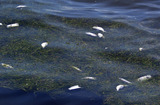
This brief investigation has students observe the phenomena of fish illness in the Chesapeke Bay and make predications based on data on the cause of the illness and the connection to the greater environmental issue at hand. AP Content Connection: Living WorldB. Natural Biogeochemical Cycles (Carbon, nitrogen, phosphorus, sulfur, water, conservation of matter)